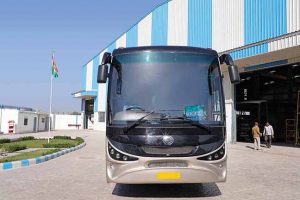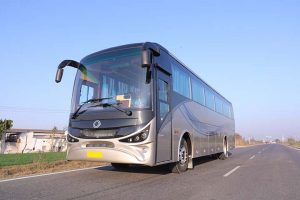GRD bus body builders is banking high upon its newly commissioned facility
Story by:
Anirudh Raheja
With bus body regulations now in place, Indian bus industry is fast progressing towards more safety for all. Where it led to some bus body builders go out of action, some increased their pace for sustainable business. Delhi based Guru Ram Dass (GRD) bus body builders is a part of the latter lot. It has been less than year of commissioning their new plant in Bahalgarh, in Sonipat near Delhi, the company is already developing buses from nine to 12 m range from its new facility and has already delivered 150 buses. As the demand for comfortable journey is picking up steam, GRD is gunning for all round growth with its newly embarked facility that spans across 20,000 sq.m. The bus body builder is lately busy building capacities for better traction and develop sustainable infrastructure to cater higher demand. Looking at a increased performance GRD is aiming at doubled up production in next one year. “From current annual capacity of 150 buses, we will double up our manufacturing capacities to roll out 300 buses annually by FY19” underscores Mayank Kukreja, CEO, GRD body builders. GRD has recently delivered 12 buses named ‘G-Dolphino’ built on Bharat Benz 12m chassis to various customers across India including Ratnagiri Transport, Sixty KMPH travel service, Satkar travels, Punja Sahib transport, Aroda Travel line. According to Kukreja, already five more G-Dolphino buses are in pipeline that will be delivered over the next two months.
G-Dolphino can be had in three versions, a 2×2 41 seater luxury bus, 2×1 executive coach 31 seater and sleeper coach. Over the last one year the company has developed three more models, viz, G-Storke, G-sharp and G-Sara. Where 80 units of G-Stroke have been delivered under 9-12 m staff bus range, three units of G-Sara have been delivered under the range of 9.5-12 m range primarily to private operators. Completing the total to 150 units, nearly 62 units of GRD’s G-Sharp model have been delivered to a tour operator in Nepal. Serving the dynamically changing demand of the consumers, GRD is also developing buses keeping in line with European norms. Informs Kukreja, “Urinals in buses have also started to gain attention and we have already delivered two buses under 41 seater 2×2 configuration with chemical toilets.”
Pointing out on the huge potential for organised bus body builders with bus body code, Kukreja stress that such players will get huge business potential with such developments. For an improved life of buses being developed at GRD and enhance production levels, the company has recently introduced a paint booth shot at its premises with an investment of Rs.58 lakhs. Though operating manually as of now, the paint booth, stresses Kukreja, is a 15m oven that reduces the possibility of dust and moisture during the paint job of the buses. “A paint booth has ensured ambient temperature while the bus is being painted, thus increased quality of the product,” he added. Under his able guidance, the company is also setting up a shower test zone with an investment of Rs.20 lakhs. “The 15 m long shower booth will be set up as per ARAI standards and will be ready in next three months,” stresses Kukreja. The shower booth will have high pressure water nozzles placed at 400 mm away from each other both longitudinally and latitudinally. Putting out a pressure up two bar, the nozzles will replace the manual checking of water leakage though pipes in the bus structure. Informs Kukreja, “Generally seen at the OEMs, the introduction of shower test will reduce any possibility of water seeping in and causing damage to the bus structure, thus enhanced product life.”
Concept to production
Though the segment currently comprises of 35 per cent of volumes at GRD, nearly half of the volumes are still lead by school and staff buses. As the demand for high end luxury travel is growing, Kukreja is gearing up to channelize its majority of its production towards such buses. Stresses Kukreja that designing every product as per the customer demand is important, but safety is of paramount importance. “Be it any design, customer comfort and safety is crucial to stay in business,” he added. Largely inspired from the wildlife birds and animals, the team at GRD is giving distinct appearance to its buses rather than copying designs fro the western world. Working in a professionally stimulating environment in the new premises, a team of four individuals undertakes the designing of a bus from the scratch. “Our goal is to finalise nearly 80 per cent of the things to be undertaken for bus body development at the time of design only,” stresses Ashok Kalsi, Technical Head at GRD. From the scratch, designing and creating the concept, draw sketches, bring it on paper, and giving final shapes in Adobe Photoshop and 3D software, the bus design is then shown to the customer for design selection. Once selected, 3D structure analysis is carried our for testing strength along with roll over tests to check robustness of the structure. “The entire process to from scratch to develop the first prototype needs three months time,” informs Kalsi. It is the rest 15-20 per cent of the physical shape of the product that is undertaken during the prototype development. “Only logical changes like product and chassis mismatch are considered at this time and the final product gets sealed,” adds Kukreja.
Keeping the shell same and as per the bill of material, additional one month is required to develop interiors of the bus as per the customer’s demand like inclusion of toilet, bar, or developing a sleeper coach. Getting attention towards the necessary approvals from regulatory authority ARAI, Kukreja avvers that it is a time consuming process, thus procedure of roping in certifications runs parallel to the development of product. “They are offered structure layout with analysis report that includes simulation and roll over tests developed in 3D for necessary checks,” adds Kukreja. Such checks include centre of gravity of vehicle, structure strength, and the geometrical design as it is meant for passenger travel, highlights Kalsi. Once the structure is ready and gets necessary approvals, it is routed to assembly for paneling and paint shop followed by pre-delivery inspection.
Currently working in one shift, GRD is sourcing chassis from the customers who buy the chassis from OEMs and give it to them for body building. GRD then develops tools and fixtures along with value engineering that also takes place in case the customer is looking for lesser price products. Kalsi feels that product development according to the environment also is important rather than blindly imitating “European buses are deployed with fabric inside, which looks good however can’t work with dusty environment in India,” informs Kalsi. Where FRP is almost getting standardized across its buses, he stresses that ABS is still not leaving the market anytime soon. “FRP bodies including front, rear and dashboard are now being demanded over ABS which is not heat resistant,” adds Kalsi. He is also looking at advanced metallurgy including aluminum for cost optimization and rigidity for the structure. To ensure ambient temperature inside the G-Dolphino, GRD has tied up with Jingyi for bus ACs and has installed a 14 tonne AC on top of G-Dolphino. Without compromising on safety, GRD has also increased its vendor list from 50 to 70 over the last one year amidst higher raw material demand and cost optimization.
Stressing that double decker coach still does not have much scope in India, however sleeper coach with bus code will bring good revolution in future. Kalsi opines that though leaf spring buses are still being supplied as the demand for them has not exited the market completely for now, as it is lead by sleeper coaches. “The absence of any regulation on sleeper coaches is still allowing such things to flourish making it unsafe for both passengers and others on the road,” said Kukreja. Adds Kalsi, “Sleeper coaches on leaf springs are dangerous. They do allow for height increase of the bus but cause much harm during roll over. He stresses that air suspensions balance the vehicle well with centre of gravity which leaf springs can’t as they operate on point load. “This is why inter city buses are largely operating on air suspensions as they are comfortable and offer stability during long journey travel,” said Kukreja. Not willing to enter into the STU business, Kukreja opines that STU market still remains extremely tight on margins. “Tighter margins do not allow any room for innovation and STU business puts a stop on your creativity which is not the case with private operators,” adds Kukreja.
OEMs on the radar
Over the last two years, GRD has already developed 68 new variants of buses that have won necessary approvals for bus body code under ARAI regulations and and somewhat similar designs are under certification at ARAI. Riding its present set up, Kukreja claims to clock 50 per cent growth in FY19. In order to stay on track for faster growth, GRD is spending almost Rs.50 lakhs annually on R&D activities to stay abreast with market’s dynamically changing demand. “To keep the costs controlled, we also recycle products without having any compromise on comfort and safety,” adds Kalsi. Though collaborations with OEMs is on the radar for GRD for faster growth, Kukreja stresses that he wants to fully build up capacities while serving the private operator. “It is important to do your homework well before knocking at OEM doors,” he concludes.






















